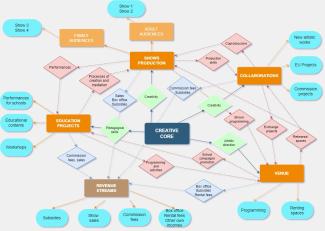
Creative relationships in artistic multi-projects optimise the opportunities for cultural organisations and artists by reducing the resources needed to generate new projects and income.
The artistic multi-projects (or artistic multi-proposals) are those that draw on the full competencies and skills of organisations or individual artists to propose a greater diversity of projects. They will target different population groups and different areas of activity.
For example, a theatre group can use its knowledge and talents to produce: theatre shows, educational projects, research, festivals, technological projects, etc. In different formats: large, small, indoor, site-specific, street, etc. It can target specific populations: adult audiences, families, communities, etc. The multi-project approach can also be applied to organisations in other disciplines: music, audiovisual, cultural centres, theatres or auditoriums.
The aim of defining the artistic multi-project is to diversify and broaden an organisation's range of projects and products, thereby strengthening its economic sustainability.
Creative Relationships of the Business Units of a Artistic Multi-Project
The business model of an artistic multi-project is structured in work areas or business units. Each work area will use one or more of its capabilities to produce differentiated projects.
The strength of multi-project business models lies in the possibility for different areas to interact with each other. For example, creative processes in artistic production areas can feed into other production areas that are not necessarily artistic but require high doses of creativity and innovation.
Creative relationships between units of the same business model increase the quality and strength of the projects generated. In this sense, they reinforce the differential and unique values of a creative organisation, offering a wider range of advantages over other competing projects. They also make better use of resources, so that the same resources can be used to generate more business opportunities and therefore more income.
In general, it can be said that sharing and diversifying resources produces better artistic and economic results than using them separately.
Graphical Representation of Creative Relationships
When an arts and creative organisation needs to redefine or transform its business model, the first step is to carry out a diagnosis. This will help it to identify the priority elements for its transformation and development. The first step in the diagnosis is to define and visualise the business model and the different areas of work, current and planned, and the creative relationships between them.
In the diagnoses we carry out in our mentoring sessions, we use the creative relationship diagram. In it we visualise the areas of work, the projects generated and the relationships between them. From this we can discover and design new areas of work and new projects to develop.
Revenue Streams
However, before going into the details of how the diagram works, one more structural element needs to be added to the representation of the business model, namely the income generation.
Any business model that aims to be economically sustainable must take into account how it generates income. Thus, to be complete, the business model of an artistic multi-project must take into account the sources of income of each of its areas and its projects. It must also consider how it monetises these different sources of income.
Case Study
The diagram shown at the beginning of this article corresponds to a fictitious but very common creative structure in the artistic sectors. It represents a performing arts organisation. In this type of structure, the interrelationships and synergies between creative and production areas are numerous and clearly beneficial to the sustainability of the overall project.
At the centre of the diagram is the creative core, the true soul of the whole project, which gives life to the different work areas or business units. These units are represented in the diagram by four orange rectangles: shows production, educational projects, collaborations and venue. Each area generates its own projects or products, represented in the diagram by blue rounded rectangles.
The direct or central creative relationships are between the creative core (dark blue rectangle) and the business units (orange rectangles). The green diamonds show the creative skills or other types of capabilities that are transferred in the relationship. On the other hand, there are also cross-cutting relationships between business units that are interrelated. The pink diamonds and dashed lines indicate the nature and content of the relationship.
At the bottom of the diagram are the different revenue systems. These are connected to the business units. The dotted lines and yellow diamonds show the origin of the revenues generated.
Graphical representations of business models, their creative relationships and their ability to generate revenue are indispensable tools in the development and transformation processes of artistic projects and organisations. It is a key methodology for our "strategic development and transformation mentoring", shedding light on the shortcomings that prevent regular and sustainable growth.
